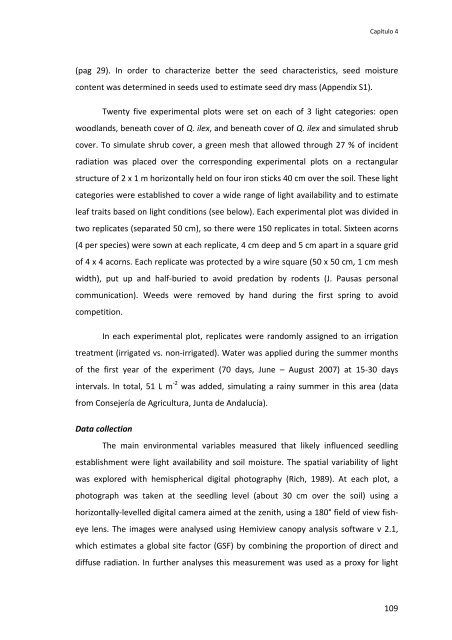Establecimiento de cuatro especies de Quercus en el sur de la ...
Establecimiento de cuatro especies de Quercus en el sur de la ...
Establecimiento de cuatro especies de Quercus en el sur de la ...
Create successful ePaper yourself
Turn your PDF publications into a flip-book with our unique Google optimized e-Paper software.
Capítulo 4<br />
(pag 29). In or<strong>de</strong>r to characterize better the seed characteristics, seed moisture<br />
cont<strong>en</strong>t was <strong>de</strong>termined in seeds used to estimate seed dry mass (App<strong>en</strong>dix S1).<br />
Tw<strong>en</strong>ty five experim<strong>en</strong>tal plots were set on each of 3 light categories: op<strong>en</strong><br />
wood<strong>la</strong>nds, b<strong>en</strong>eath cover of Q. ilex, and b<strong>en</strong>eath cover of Q. ilex and simu<strong>la</strong>ted shrub<br />
cover. To simu<strong>la</strong>te shrub cover, a gre<strong>en</strong> mesh that allowed through 27 % of inci<strong>de</strong>nt<br />
radiation was p<strong>la</strong>ced over the corresponding experim<strong>en</strong>tal plots on a rectangu<strong>la</strong>r<br />
structure of 2 x 1 m horizontally h<strong>el</strong>d on four iron sticks 40 cm over the soil. These light<br />
categories were established to cover a wi<strong>de</strong> range of light avai<strong>la</strong>bility and to estimate<br />
leaf traits based on light conditions (see b<strong>el</strong>ow). Each experim<strong>en</strong>tal plot was divi<strong>de</strong>d in<br />
two replicates (separated 50 cm), so there were 150 replicates in total. Sixte<strong>en</strong> acorns<br />
(4 per species) were sown at each replicate, 4 cm <strong>de</strong>ep and 5 cm apart in a square grid<br />
of 4 x 4 acorns. Each replicate was protected by a wire square (50 x 50 cm, 1 cm mesh<br />
width), put up and half‐buried to avoid predation by ro<strong>de</strong>nts (J. Pausas personal<br />
communication). Weeds were removed by hand during the first spring to avoid<br />
competition.<br />
In each experim<strong>en</strong>tal plot, replicates were randomly assigned to an irrigation<br />
treatm<strong>en</strong>t (irrigated vs. non‐irrigated). Water was applied during the summer months<br />
of the first year of the experim<strong>en</strong>t (70 days, June – August 2007) at 15‐30 days<br />
intervals. In total, 51 L m ‐2 was ad<strong>de</strong>d, simu<strong>la</strong>ting a rainy summer in this area (data<br />
from Consejería <strong>de</strong> Agricultura, Junta <strong>de</strong> Andalucía).<br />
Data collection<br />
The main <strong>en</strong>vironm<strong>en</strong>tal variables mea<strong>sur</strong>ed that lik<strong>el</strong>y influ<strong>en</strong>ced seedling<br />
establishm<strong>en</strong>t were light avai<strong>la</strong>bility and soil moisture. The spatial variability of light<br />
was explored with hemispherical digital photography (Rich, 1989). At each plot, a<br />
photograph was tak<strong>en</strong> at the seedling lev<strong>el</strong> (about 30 cm over the soil) using a<br />
horizontally‐lev<strong>el</strong>led digital camera aimed at the z<strong>en</strong>ith, using a 180° fi<strong>el</strong>d of view fisheye<br />
l<strong>en</strong>s. The images were analysed using Hemiview canopy analysis software v 2.1,<br />
which estimates a global site factor (GSF) by combining the proportion of direct and<br />
diffuse radiation. In further analyses this mea<strong>sur</strong>em<strong>en</strong>t was used as a proxy for light<br />
109

















